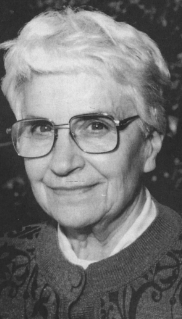| Denise Albe-Fessard | |
|---|---|
 | |
| Born | Denise Gabrielle Henriette Marie Albe 31 May 1916 Paris, France |
| Died | 7 May 2003 (aged 86) |
| Nationality | French |
| Alma mater | ESPCI Paris (Dipl. Ing., 1937) University of Paris (PhD, 1950) |
| Known for | Electrophysiology, Neurophysiology |
| Spouse |
Alfred Fessard [fr]
(m. 1942; died 1982) |
| Children | Jean Fessard |
| Awards | Knight of the Legion of Honour (1973) Officer of the Ordre national du Mérite (1978) |
| Scientific career | |
| Thesis | Recherches électrophysiologiques sur la décharge du gymnote, de la torpille, de la Raie. Etude des facteurs centraux et périphériques de son organisation (1950) |
Denise Albe-Fessard (French pronunciation: [dəniz albəfesaʁ] ; 31 May 1916 – 7 May 2003), née Denise Gabrielle Henriette Marie Albe, was a French neuroscientist best known for her basic research into the central nervous system pain pathways, clarifying the distinction between lateral and medial thalamic pain processing. She was named a Chevalier (Knight) of the Legion of Honour and an Officer of the Order of Merit.
Early life and education
Denise Albe-Fessard was born in Boulogne-Billancourt, France during the First World War to parents from farmer and artisan backgrounds. Her father was a railway engineer who aided in the construction of tracks that carried soldiers and ammunition to the front lines. She was the youngest child out of four and had the opportunity to receive the same education as her two brothers because this was more acceptable in Paris than it was in the provinces from which her family originated. At the age of 10, she passed a competitive scholarship examination in her state primary school and received a free secondary education. She proceeded to earn an engineering degree in 1937 at School of Physique et Chimie de Paris, specializing in physics under the advice of her brother not to pursue medicine due to the struggles that women in that field faced. She graduated with a doctoral degree from University of Paris in 1950.
Career and research
After graduating ESPCI Paris in 1937, she struggled to find work as a female physicist and joined Rhône-Poulenc as a chemist. After a month there, she quit and joined the Centre National de la Recherche Scientifique (CNRS) as a technical assistant for Daniel Auger, a plant electrophysiologist. Working with amplifiers to measure electrical potentials of Nitella introduced Albe-Fessard to the limitations of recording bio-electric phenomena.
During her work with Daniel Auger, she met the nervous physiologist and electrophysiologist Alfred Fessard [fr] (1900–1982), whom she married in 1942. It was Albe-Fessard who constructed the electronic equipment that Fessard used to make the stimulators and amplifiers necessary for his study of electrophysiology. She went on to become the director of the physiological laboratory of nervous centers of the Sciences faculty.
Early on, Albe-Fessard studied the electrical activity of electric fish. Her work on microelectrode recordings of a cat's cerebral cortex in the 1950s was one of the first intracellular recordings of a mammalian brain.
Albe-Fessard chaired the scientific committee of the first international congress on pain in 1975 in Florence, Italy. From 1978 to 1984, she was a member of various other committees.
She was the first president of the International Association for the Study of Pain (IASP) between 1975 and 1978.
Honours and awards
- Knight of the Legion of Honour (1973)
- Officer of the Ordre national du Mérite (1978)
- Elected as the first president of the International Association for the Study of Pain (IASP) (1975–1978)
- Auditorium Salle Denise Albe-Fessard at the French UMR Institut des Neurosciences Paris-Saclay (NeuroPSI) is named after her.
Notable publications
- Atlas stéréotaxique du diencéphale du rat blanc, 1966
- La Douleur : ses mécanismes et les bases de ses traitements, 1996
References
- deces
.matchid .io /id / _z7v1biwm-rb - ^ The history of neuroscience in autobiography. Squire, Larry R., Society for Neuroscience. Washington DC: Society for Neuroscience. 1996. ISBN 0-916110-51-6. OCLC 36433905.
{{cite book}}: CS1 maint: others (link) - "In Memoriam: Denise Albe-Fessard". International Association for the Study of Pain. Retrieved 7 June 2014.
- Recherches électrophysiologiques sur la décharge du gymnote, de la torpille, de la Raie. Etude des facteurs centraux et périphériques de son organisation (Ph.D. thesis). Université de Paris. 1950. OCLC 493593273.
- ^ "Club d'histoire des neurosciences - History of neurosciences club". www.biusante.parisdescartes.fr. Retrieved 2022-03-22.
- Shepherd, Gordon M. (2010). Creating Modern Neuroscience: The Revolutionary 1950s. Oxford: Oxford University Press. pp. 139–140. ISBN 978-0-19-974147-2.
Denise Albe-Fessard.
- ^ "In Memoriam: Denise Albe-Fessard - IASP". www.iasp-pain.org. Archived from the original on 2020-11-28. Retrieved 2020-09-17.
- neuropsi
.cnrs .fr /events /femmes-en-science-a-neuropsi
Further reading
- Barraquer-Bordas L. (Nov 2003). "In memoriam. Denise Albe Fessard (1916-2003)". Revista de Neurología (in Spanish). 37 (9): 898–900. PMID 14606060.
- Berkley, K. J. (2004). "Madame Albe-Fessard: A meaningful legacy". European Journal of Pain. 8 (2). London, England: 95–7. doi:10.1016/j.ejpain.2003.11.008. PMID 14987613.
- Rokyta, Richard (2004). "In memoriam of Professor Denise Albe-Fessard". European Journal of Pain. 8 (2). London, England: 107–108. doi:10.1016/j.ejpain.2003.11.013.
- Larry R. Squire, ed. (1996). "Denise Albe-Fessard". The History of Neuroscience in Autobiography VOLUME 1. Washington D.C: Society for Neuroscience. ISBN 0-916110-51-6.